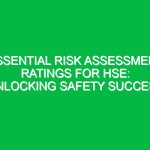Introduction
Hello team! Today, we’re gathering for a Toolbox Talk focused on a critical aspect of our daily operations: Common Unsafe Behaviors in Construction Safety. As we embark on our work, it’s essential to recognize and address these unsafe behaviors to ensure not only our Safety but also the safety of our colleagues. By understanding these behaviors, we can create a safer working Environment and minimize the risk of accidents.
Understanding Unsafe Behaviors
Unsafe behaviors in the construction industry can lead to severe accidents, injuries, or even fatalities. These behaviors often stem from a lack of awareness, complacency, or disregard for safety protocols. Identifying and correcting these behaviors is vital in fostering a culture of safety on our job sites. Let’s explore some of the most common unsafe behaviors we encounter in construction safety.
1. Not Wearing Personal Protective Equipment (PPE)
One of the most prevalent unsafe behaviors is failing to wear appropriate Personal Protective Equipment (PPE). Hard hats, Safety Goggles, gloves, and steel-toed boots are essential in protecting us from potential Hazards. For example, a worker who skips wearing a hard hat while working near overhead tasks is at a higher risk of head injuries. Remember, PPE is not just a recommendation; it’s a requirement designed to keep you safe.
2. Ignoring Safety Protocols
Each job site has established safety protocols designed to mitigate risks. Ignoring these protocols is a common Unsafe Behavior that can have dire consequences. For instance, if someone chooses to skip the safety briefing or bypasses equipment checks, they may not be aware of the risks involved in their tasks. Always review safety protocols before starting work, and don’t hesitate to ask questions if something is unclear.
3. Improper Use of Tools and Equipment
Using tools and machinery incorrectly is another significant unsafe behavior. Each tool comes with specific instructions and safety features. A real-life example is a worker attempting to use a power tool without first reading the manual or receiving proper Training. This lack of knowledge can lead to accidents or injuries. Always ensure you are trained and comfortable using any equipment before beginning your tasks.
4. Working While Fatigued
Fatigue can severely impair our judgment and reaction times. Working long hours without adequate breaks can lead to mistakes and unsafe conditions. For instance, a tired worker might overlook a safety measure, increasing their risk of injury. It’s crucial to recognize your limits and communicate with your supervisor if you feel fatigued. Taking breaks and ensuring you’re well-rested is essential for maintaining safety on the job site.
5. Horseplay and Distractions
Engaging in horseplay or allowing distractions on the job site is a common unsafe behavior that can lead to accidents. For example, joking around while handling heavy machinery can take your focus away from the task at hand and result in mishaps. Always maintain professionalism and focus on your tasks. If you notice distractions, address them immediately to prevent accidents.
Recognizing Potential Hazards
Understanding the common unsafe behaviors is only part of the equation. We also need to be vigilant about recognizing potential hazards associated with these behaviors.
1. Environmental Hazards
Construction sites are filled with environmental hazards, including uneven surfaces, falling objects, and Electrical Hazards. For instance, if someone is not wearing a hard hat, they are exposed to the risk of head injuries from falling materials. Always be aware of your surroundings and report any hazards to your supervisor.
2. Equipment Hazards
Improper equipment use not only endangers the user but also those around them. For example, a worker using a forklift without proper training can cause severe accidents. It’s vital to ensure everyone operating equipment is trained and adheres to safety protocols to prevent incidents.
3. Human Factors
Human factors such as fatigue, stress, and distractions can contribute to unsafe behaviors. Recognizing when a colleague is overwhelmed or exhausted and offering support can help maintain a safer environment. Creating a culture of openness where employees feel comfortable discussing their challenges is crucial for enhancing overall safety.
Best Practices to Mitigate Unsafe Behaviors
Now that we’ve identified common unsafe behaviors and potential hazards, let’s talk about Best Practices to mitigate these risks.
1. Regular Safety Training
Participating in regular safety training sessions is essential for keeping safety protocols fresh in our minds. These sessions reinforce the importance of PPE, proper tool usage, and awareness of hazards. Make sure to attend all scheduled training and actively participate in discussions.
2. Encourage Open Communication
Creating an environment where team members feel comfortable discussing safety concerns is key. Encourage your coworkers to share their observations and suggestions regarding safety practices. If you see someone engaging in unsafe behavior, kindly remind them of the proper protocols. Open communication can lead to a stronger safety culture.
3. Conduct Regular Safety Inspections
Regular safety inspections help identify and address potential hazards before they lead to accidents. Supervisors should conduct daily checks of the worksite and equipment to ensure everything is in safe working order. Encourage your team to report any unsafe conditions immediately.
4. Lead by Example
As a team member, you play a crucial role in promoting safety. Always adhere to safety protocols and demonstrate safe behaviors. When others see you prioritizing safety, they are more likely to follow suit. Remember, safety starts with each one of us.
5. Take Breaks and Stay Hydrated
Encouraging regular breaks and hydration can help combat fatigue and maintain focus. Make it a point to step away from your tasks periodically and drink water. Staying refreshed can significantly reduce the risk of accidents caused by fatigue or distraction.
Real-Life Examples and Scenarios
Let’s take a moment to consider some real-life scenarios that highlight the importance of addressing unsafe behaviors in construction safety.
Scenario 1: The Importance of PPE
Imagine a construction worker named John who frequently neglects to wear his hard hat. One day, while lifting materials, a tool accidentally falls from above and strikes him. If John had followed safety protocols and worn his hard hat, he would have significantly reduced his risk of injury. This scenario underscores the importance of PPE in protecting ourselves and our colleagues.
Scenario 2: The Consequences of Fatigue
Consider Sarah, a team member who frequently works overtime. One day, feeling fatigued, she miscalculates a measurement while operating heavy machinery. This mistake leads to a costly error and damages equipment. By recognizing her fatigue and taking a break, Sarah could have avoided this situation. It emphasizes the need to listen to our bodies and prioritize our well-being.
Scenario 3: The Role of Communication
Let’s think about a situation where a new employee, Mike, is unsure about the safety protocols. Instead of asking for help, he decides to figure it out on his own. This leads to him misusing a piece of equipment, resulting in an accident. If Mike had felt comfortable communicating his concerns, the incident could have been prevented. This scenario highlights how vital open communication is in fostering a safe work environment.
Regulations and Standards
It’s crucial to be aware of relevant Regulations and standards that govern our work in construction safety. Organizations such as the Occupational Safety and Health Administration (OSHA) provide guidelines designed to protect workers in various industries, including construction.
1. Compliance with osha Standards
Understanding and complying with OSHA standards is not optional; it’s a legal requirement. These standards cover everything from PPE to machinery Operation and Fall Protection. Non-compliance can result in fines, but more importantly, it puts our safety at risk. Always stay informed about the latest OSHA regulations and how they apply to our work.
2. Company Policies and Procedures
In addition to OSHA regulations, our company has specific policies and procedures in place to enhance safety. Familiarize yourself with these guidelines, as they are tailored to our unique work environment. Adhering to both company policies and OSHA regulations is essential for maintaining a safe workplace.
Conclusion
Today, we’ve discussed Common Unsafe Behaviors in Construction Safety and how they impact our daily operations. By recognizing these behaviors, understanding potential hazards, and implementing Best Practices, we can all contribute to a safer work environment. Remember, safety is a shared responsibility, and it starts with each one of us.
Thank you for your attention and your commitment to safety. Let’s work together to ensure that we return home safely at the end of each day. If you have any questions or concerns about today’s discussion, please feel free to share them now!


